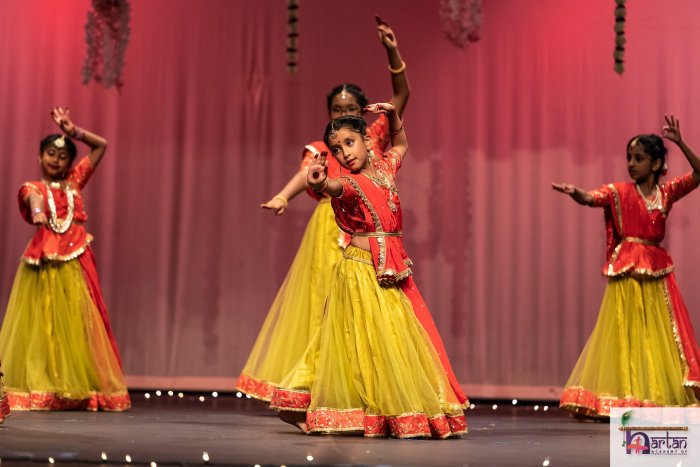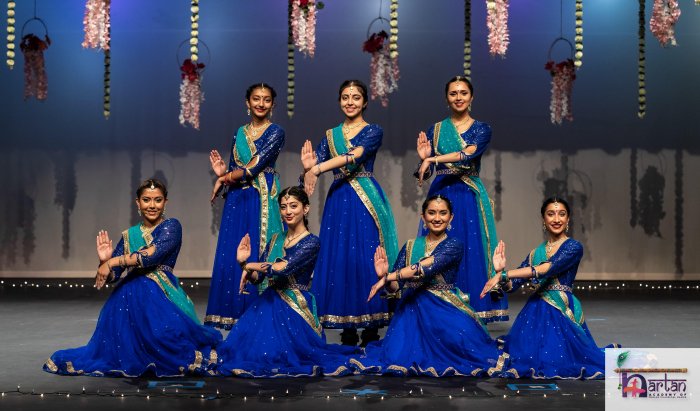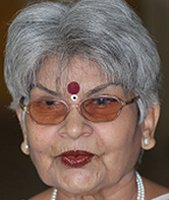
|   |

|   |
Nartan Academy's 'Nritya Navonmesh' - Manjari Sinha e-mail: manjari@sinha.com June 23, 2022 The Nartan Academy of Indian Classical Dance, Maryland, USA, presented 'Nritya-Navonmesh' as a revival of their biennial festival of Kathak, at the Quince Orchard High School Auditorium, Gaithersburg, MD recently. It was a rejuvenation of dance after the devastating pandemic period that shut everything down for the past two years. The Zoom classes started by Guru Purvi Rajyaguru Bhal came as the silver lining amidst the dark clouds, when the regular classes came to a standstill. She prepared nearly seventy of her students from across the US, taught them her new choreographies conceived for 'Nritya-Navonmesh' on Zoom and put up this in-person grand show. The apparent verve and zest of the festival attended by a houseful audience spoke of the meticulous preparations that must have gone into it. The Nartan Academy was established by Purvi Rajyaguru Bhal with the blessings of her own Guru Dharmshi Bhai Shah, the founder of Kalakshetra Dance & Music School, Bhavnagar, Gujarat. Initiated into Indian music and dance at Santiniketan and later groomed at the Uday Shankar Cultural Centre, Almora, Guru Dharmshi Bhai Shah was trained in four of the Indian classical dance forms including Kathak under Guru Sundar Lal Gangani, Odissi under Guru Kelucharan Mohapatra, Bharatanatyam under Guru Rajagopalan and Kathakali under Guru Kunjunayak Valankada of Malabar. Purvi Rajyaguru Bhal, the founder and artistic director of Nartan Academy was initiated into dance by her mother Usha Rajyaguru and was later groomed under Guru Dharmshi Bhai Shah when he accepted Purvi as his disciple. A Visharad (Bachelor of Arts) from Gandharva Mahavidyalaya Mandal, Purvi also earned the degrees of Shiksha Visharad and Alankar Pratham. Over the years she has taught Kathak to a new generation of Indian Americans in the DC Metro area, introducing young kids to Indian classical culture and helping them understand Indian mythological stories and concepts like Nava Rasa from the Natya Shastra of Bharata Muni. Purvi teaches her students both theory and practice of Indian classical music and dance by creating and following a prescribed curriculum and examination system for evaluation. She herself has continued learning and maintaining a close creative partnership with the senior disciples of her Guru Dharmshi Bhai Shah like Murali Mohan Kalvakalva, Tushar Bhatt and Pooja Bhatt and also the admirable work of senior artistes like Guru Geetanjali Lal of Jaipur Gharana and Durga Arya of Lucknow Gharana of Kathak. She had, for instance, collaborated with Durga Arya while presenting 'Nritya Arpanam' to celebrate the birth centenary of Guru Dharmshi Bhai Shah in 2020.  'Nritya-Navonmesh' featured her students ranging from budding to emerging dancers and senior seasoned ones of different age groups, showcasing her latest choreographies. The aesthetic ambience of the venue, the stage decor and the invocatory 'Deep-Jyoti Shloka' for the auspicious lighting of the lamp, rendered by Kuhoo Bhal in a reposeful manner with total tunefulness, besides the neatly enunciated lyrical content, captured one's attention from the very beginning. The Guru Vandana by Purvi herself initiated the sequence of items incorporating both nritta and abhinaya aspects of Kathak, opening with Shiva Stuti. This invocation to Nataraja was very thoughtfully composed in raga Bhairava, which is also a synonym of Shiva, and set to chautala in the Dhrupad style, performed by a group of seven well-trained dancers namely Tanushree, Deepti, Anusha, Shubhangini, Disha, Simran and Sahiba, eulogizing Shiva's attributes. Next came the tiny tots, Veda, Sana Krishna, Hamara, Raanya, Saanvi and the remarkably graceful Sathyana Patel dancing to 'Achyutam Keshavam', who stole the hearts of rasikas. After this, "Sudar Gopalam..." composed by Asit Desai and sung melodiously by Alap Desai in raga Kirwani, evoked the Natawara who created the very first mnemonics of Kathak while dancing on the hoods of the serpent Kaliya in the mythological story of 'Kaliya Daman', interspersed with Tode, Tukde, Paran et al were performed by Mythily, Shivangi, Bina, Mainali, Nutan, Saujanya and Babita. Teentaal, the most important and basic rhythmic cycle of Kathak was performed by three age groups of dancers, placed in-between a variety of items set to different musical genres like Tarana, Trivat and Hori etc., comprising an attractive garland of group choreographies created for 'Nritya Navonmesh'. The first group of six dancers Niyoshi, Renya, Aarna, Jiya and Lavanya presented Shuddha Nritta, with the traditional Thaat, Aamad, Paran-Jodi Aamad "Dhatak Thunga..." et al on the melodious lehra (musical refrain) of Maru Bihag concluding with crisp footwork.  The Malhar Tarana from the Coke Studio famed 'Malhar Jam', composed by Krishna Janakiram for the Rock Band Agam and sung by Harish Shivaramkrishnan accompanied by instruments like acoustic drums, guitar, piano along with the Indian esraj, flute and sitar, had altogether a different flavour right from choreography to costumes. Graceful dancers like Veda Karma Shreshtha in black Anarkali with multi-coloured sharara underneath, looked gorgeous with this costume with a twist to match the music and dance. The Kaushik Dhwani Trivat was a rare piece composed by Samanvita Sharma with vocals by Samanvita herself and Keerthana Holla, tabla and pakhawaj by Venugopal Raju, sitar by Shruti Kamath, flute by Mahesh Swamy and Padhant by Murali Mohan Kalvakalva. This rhythmic choreography was performed by Niyati, Saisha, Ishani, Annika, Shreya, Aashi and Ananya, and comprised Tode, Tukde Sargam and Kavitta, echoing the complicated rhythmic patterns of the percussions with the neat and crisp clarity of footwork climaxing with a Chakradar Tihai. The recorded version of the poetic composition of Pt Birju Maharaj "Shri Krishna Nirtat Thunga Thunga", written, composed and sung by Maharaj himself accompanied by Rakesh Chaurasia on flute, Fateh Singh Gangani on tabla and Mahaveer Gangani on pakhawaj was outstanding in its choreography and its synchronized execution by senior students like Shruti Sinha Pal, Mythily Arun, Shivangi Ganatra, Shrividya and Nutan Ravool. This was preceded by "Hori khelat hain Girdhari" with the festivity of 'Braj ki Holi', the festival of colours evoked by the rhythmic tapestry of the composition itself and the incorporated Kavitta on the same theme and the folk fervour of Garba.  The second group of well-groomed dancers like Tanushree Pal, Sneha, Shivani, Disha and Surabhi Singh performed Teentaal opening with the famous 'Ganesh-Paran' composed by Pt. Kishan Maharaj in slow tempo with the Paran-Jodi Amad "Dhatak thunga..." et al before proceeding to the medium tempo with Ginti ki Tihais, Gat-Nikas and Gat-Bhava to the climaxing Tatkaar. This was followed by 'Varsha Ritu' composed and sung by Samanvita in Brindavani Sarang and danced by a group of seven dancers followed by an Amir Khusro Tarana in raga Kalavati. The last group danced to Teentaal on the musical refrain of raga Saraswati interspersed with the Parans of Pt. Sundar Lal Gangani, had strikingly chiselled dancers like Prisha Bhal, Pragya, Swara, Saesha, Nitya and Pankhuri. This smoothly flowed into the Sanskrit shlokas "Sarve bhavantu sukhinah", a prayer for the well-being of one and all with peace and harmony in the whole universe and the Shanti Mantra composed and soulfully sung by Asit Desai, when all the dancers heralded by their Guru Purvi Bhal herself, reached 'Nritya Navonmesh' to its climax. Special mention needs to be done for Shruti Sinha Pal, the Sutradaar, who established instant rapport with the audiences and took them along while anchoring the grand show. Also to the costume designer Vishakha Buche and the set designer Kanwal Singh who took care of the whole decor. The hanging floral decor looked good with the light design when the curtain opened for the first time but one wished them pulled up while the dance sequences went on. Kudos to Nartan Academy and Guru Purvi Bhal for training so many students and cultivating such a large number of devoted rasikas for Indian music and dance in such a faraway land.  Manjari Sinha has an M.A. in Sanskrit and Music, and trained in vocal, tabla, sitar and Kathak dance. She has regular columns in national dailies as a music and dance critic. |